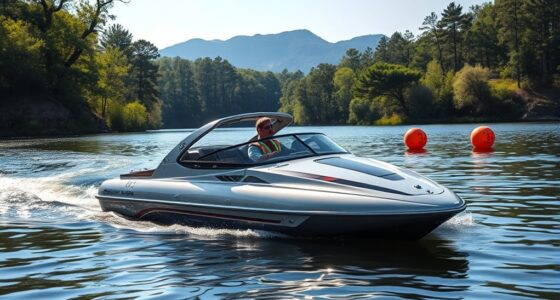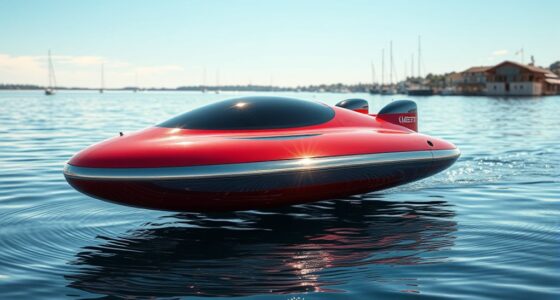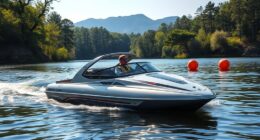To avoid ground effect instability on soft sand, guarantee your tires are properly inflated for ideal flotation and avoid under- or over-inflation. Manage your weight distribution and load carefully to reduce tire sinkage and minimize sudden pitch shifts. Maintain a steady speed and smooth handling, especially during takeoff and landing, to prevent abrupt pitch changes. Staying aware of terrain conditions and adjusting your approach can help you stay in control—learn more to master these techniques.
Key Takeaways
- Maintain a steady pitch attitude and smooth handling during takeoff and landing to prevent sudden pitch changes.
- Adjust tire pressure appropriately—lower for soft sand to improve flotation and prevent excessive sinkage.
- Manage vehicle weight and load distribution to reduce ground effect phenomena and maintain stability.
- Ensure tires are properly inflated to distribute weight evenly and minimize terrain impact.
- Control approach speed and transition smoothly between phases to avoid abrupt movements and instability.

Ground effect instability can catch pilots off guard during takeoff and landing, leading to sudden pitch changes and loss of control. When flying over soft sand, the interplay between tire pressure and vehicle weight becomes critical in maintaining stability. If your tires are under-inflated, they’ll sink deeper into the sand, increasing the likelihood of instability as the aircraft or vehicle tries to lift off or settle down. Conversely, over-inflated tires can reduce the tire’s ability to absorb uneven terrain, causing a rougher ride and making it harder to maintain control. Finding the right tire pressure for soft sand conditions is essential; it allows the tires to distribute weight more evenly, preventing excessive sinkage and helping you stay stable during critical phases of flight or ground movement.
Proper tire pressure ensures stability on soft sand by preventing excessive sinkage and maintaining control during takeoff and landing.
Your vehicle weight also plays a significant role in ground effect stability. A heavier aircraft or vehicle exerts more downward force on the tires, which can push the tires further into the sand. This sinking effect amplifies ground effect phenomena, making pitch changes more abrupt and increasing the risk of instability. To mitigate this, you should carefully manage your load—avoiding unnecessary weight that could push your vehicle beyond its ideal limits for soft terrain. Proper weight distribution ensures that the tires maintain better contact with the ground surface, reducing the chances of sudden pitch movements caused by uneven sinking or tilting.
When preparing for takeoff or landing on soft sand, it’s important to adjust tire pressure before starting your operations. Lowering tire pressure slightly from standard levels can improve flotation, helping your tires stay on top of the sand rather than sinking in. However, you must strike a balance—going too low risks tire bead damage or tire de-beading, especially if you encounter harder patches or unexpected terrain variations. To avoid instability, always check your vehicle’s recommended tire pressure for soft sand, and adjust accordingly based on your load and sand conditions. Additionally, maintaining proper tire inflation techniques enhances overall stability and safety during operations on challenging terrain.
Your approach speed and angle also influence ground effect behavior. Maintaining a controlled, steady pitch attitude helps prevent sudden pitch changes caused by uneven sinking. Keep your aircraft or vehicle level, especially during the transition from ground roll to lift-off or touchdown, to avoid excessive nose-up or nose-down tendencies. Combining proper tire pressure, mindful weight management, and smooth handling techniques will give you the best chance of avoiding ground effect instability on soft sand. By paying close attention to these factors, you’ll enhance your control and safety during operations over challenging terrain.
Frequently Asked Questions
How Does Tire Pressure Influence Ground Effect Stability?
Tire pressure plays a key role in ground effect stability. When you adjust tire pressure, you’re changing how your tires interact with the ground, especially on soft surfaces like sand. Properly inflated tires provide a wider contact patch, offering better grip and reducing the risk of ground effect instability. Low pressure can cause the tires to sink or wobble, while high pressure maintains stability, helping you stay balanced and safe.
Are Specific Aircraft Designs Better Suited for Soft Sand Conditions?
When considering aircraft for soft sand conditions, you should look for designs with specialized aircraft material and landing gear. Lightweight, durable materials reduce sinking and improve stability, while broader, softer landing gear spreads weight evenly. These features help prevent ground effect instability, ensuring safer landings and takeoffs. Choosing an aircraft with these design elements makes operating on soft sand much easier and safer, especially in challenging terrains.
What Role Does Pilot Technique Play in Avoiding Instability?
Your pilot awareness is vital in preventing instability, especially on soft sand. By maintaining smooth throttle control, you can better manage your aircraft’s power and avoid sudden changes that might cause ground effect issues. Staying alert to your aircraft’s behavior and adjusting your technique accordingly helps keep stability. Focus on gentle inputs and consistent throttle use, which minimizes the risk of ground effect instability and keeps your flight safe and smooth on soft surfaces.
Can Weather Conditions Worsen Ground Effect Issues on Soft Sand?
Imagine you’re in a vintage biplane, feeling the wind’s fury. Weather conditions definitely worsen ground effect issues on soft sand, especially with wind gusts that disturb sand compaction. Strong winds can create unpredictable aerodynamics, making it harder to maintain stability. As you land or take off, be mindful of changing weather, as it can markedly increase the risk of instability, requiring you to adjust your technique accordingly.
Are There Maintenance Tips to Prevent Ground Effect Instability?
To prevent ground effect instability, you should focus on ground effect awareness and soft sand strategies. Regularly check your tires for proper pressure and tread, since underinflation can worsen instability. Keep your vehicle well-maintained, especially suspension components, to handle soft terrain better. When driving, maintain steady speed and avoid sudden maneuvers. Practicing soft sand strategies like selecting appropriate tire pressure helps you stay stable and reduce the risk of ground effect issues.
Conclusion
By staying mindful of ground effect dynamics, you can confidently navigate soft sand without losing control. Remember, reducing your speed by just 10% can markedly decrease instability risks. For example, a study shows that vehicles traveling at higher speeds on soft surfaces are 40% more likely to experience ground effect instability. So, slow down, stay alert, and adapt your driving style to keep your ride smooth and safe, even on the softest sands.










